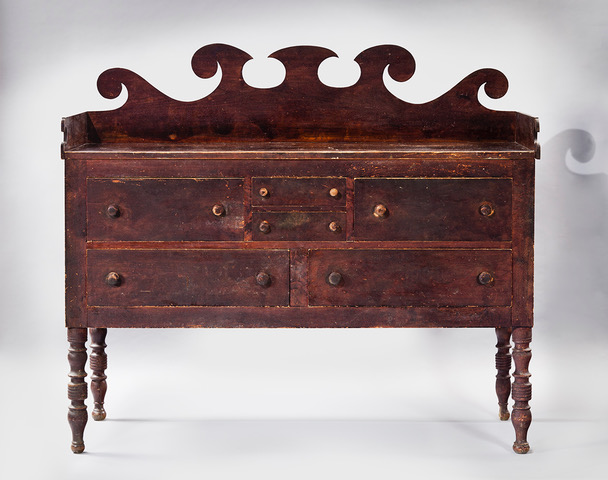

Slab Sideboard Burgner Group/ Christian Burgner (1811-1886) 1840-1860 H: 59 1/2" W: 67 3/4" D: 27 1/4" Greene County, Tennessee
William King Museum of Art presents “Tennessee Fancy: Decorative Arts of Northeast Tennessee 1780-1940.” This exhibition takes a look at what made the decorative arts of Tennessee unique, and how style flourished across the state line. Known for a short time as the State of Franklin, the counties of Northeast Tennessee produced artists that created bold designs, from the cobalt and manganese glazes on pottery from Haun, Decker and Cain, to the highly patterned woods and rope and tassel inlay of Greene County cabinetmakers. Woven coverlets and pieced quilts from the region have geometric patterns inspired by the traditions of those traveling along the Great Road to make a new home on the frontier, and itinerant artists came into the region to paint portraits for settlers, educating a new generation of painters in Tennessee. Although many of these painters remain unknown, William Harrison Scarborough and Samuel Shaver enjoyed successful careers creating portraits in Sullivan and Hawkins Counties.
The traditions and heritage of the early settlers in Tennessee began to develop into a unique decorative style as Chippendale, Hepplewhite and Sheraton cabinetry styles trickled in along the Great Road, and as German, English, Scottish and Irish immigrants pushed westward after the American Revolution. Throughout the 19th century, Tennessee’s style was cultivated by waves of settlers and pioneers expanding further west. They drove the market by seeking to fill their homes with functional pieces that also reflected their newfound prosperity and permanence. By the mid-19th century, Tennessee had developed a style all its own, sometimes outstandingly decorative, sometimes oddly curious, but always ... fancy.
“Tennessee Fancy: Decorative Arts of Northeast Tennessee, 1780-1940” is an exhibition of William King Museum of Art’s Cultural Heritage Project. The project’s goal is to broaden the record of objects made by hand in Southwest Virginia and Northeast Tennessee prior to 1940 and to foster a full and accurate appreciation of this region’s role in American decorative arts. Initiated in 1994 with a grant from the National Endowment for the Arts, the Project conducted a first-time door-to-door survey in 15 counties: the Virginia counties of Buchanan, Dickenson, Lee, Russell, Scott, Smyth, Tazewell, Washington and Wise and the Tennessee counties of Carter, Greene, Hawkins, Johnson, Sullivan and Washington. The baseline survey lasted two years, and its 2000 records were used to create the project’s first exhibitions during the late 1990s.
Research has continued, and today the survey records are kept in a permanent archive, numbering almost 4,000, and have been used to inform over 40 exhibitions, a permanent collection and two books published by university presses.
Recently, the records have been uploaded onto a new database, Cultural Heritage Archive, Online. Located on the museum’s website under archive, the Southwest Virginia and Northeast Tennessee legacy of furniture, pottery, textiles, metalwork, art, musical instruments, and baskets can be appreciated by a worldwide audience.
“Tennessee Fancy: Decorative Arts of Northeast Tennessee,” sponsored by The Bank of Tennessee with additional support from Rea Charitable Trust and Massengill-DeFriece Foundation, is on display April 1 through Oct. 31, at the William King Museum of Art’s Cultural Heritage Gallery. Masks and social distancing required in building. For more information, and to schedule a tour, visit williamkingmuseum.org or call (276) 628-5005 x113.
The museum is open seven days a week: Monday through Saturday from 10 a.m. to 5 p.m. and Sunday from 1 p.m. to 5 p.m. Admission to the museum is free. For information on exhibitions or events at William King Museum of Art visit williamkingmuseum.org or call 276-628-5005. Register for classes and events on WKMA’s website.
The museum is accredited by the American Alliance of Museums. It is a partner of the Virginia Museum of Fine Arts, a member of the Virginia Association of Museums, and is funded in part by the Virginia Commission for the Arts and the National Endowment for the Arts.
READ ON: Upper East Tennessee historic sites are worth exploring